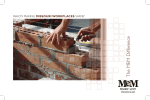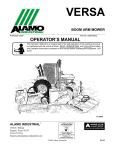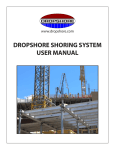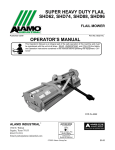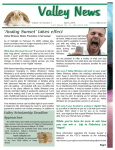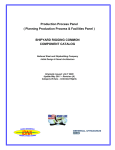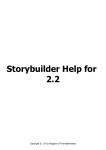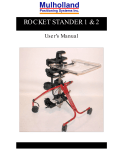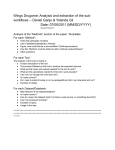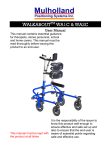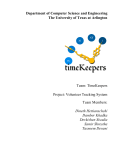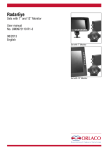Download Construction Safety Book
Transcript
The MEM Difference who’s Making MisSOURI WORKPLACES SAFER? CONSTRUCTION SAFETY www.mem-ins.com 7/11 These materials are provided for informational purposes only. Missouri Employers Mutual assumes no liability for the use or sufficiency of the information provided. The applicability of this information to your specific workplace can be determined only in consultation with your own legal counsel and/or safety professional. Our Mission We provide innovative, cost-effective solutions employers need to create safe, healthy and injury-free workplaces. This guide is intended to explain in easily understood terms the safe work practices roofers could utilize to eliminate injury and assist in meeting some OSHA requirements. This guide does not replace any requirements detailed in actual OSHA regulations for construction, and it should be used only as a companion to the actual regulations. Vision Our Vision Safe, healthy and injury-free workplaces. SM Table of Contents WorkSAFE . . . . . . . . . . . . . . . . . . . . . . . . . . . . . . . . . . . . . . . . . . . . . . . . . . . . 6 Safe Driving . . . . . . . . . . . . . . . . . . . . . . . . . . . . . . . . . . . . . . . . . . . . . . . . . . . 7 Seat Belt Policy . . . . . . . . . . . . . . . . . . . . . . . . . . . . . . . . . . . . . . . . . . . . . . . . .8 Fall Protection . . . . . . . . . . . . . . . . . . . . . . . . . . . . . . . . . . . . . . . . . . . . . . . 9-23 Tools and Equipment . . . . . . . . . . . . . . . . . . . . . . . . . . . . . . . . . . . . . . . . 24-28 Education . . . . . . . . . . . . . . . . . . . . . . . . . . . . . . . . . . . . . . . . . . . . . . . . . . . .29 Tool Box Talks . . . . . . . . . . . . . . . . . . . . . . . . . . . . . . . . . . . . . . . . . . . . . . . . . 32 Seat Belt Use . . . . . . . . . . . . . . . . . . . . . . . . . . . . . . . . . . . . . . . . . . . . 31 Housekeeping . . . . . . . . . . . . . . . . . . . . . . . . . . . . . . . . . . . . . . . . . . . 33 Eye Protection . . . . . . . . . . . . . . . . . . . . . . . . . . . . . . . . . . . . . . . . . . . .35 Scaffolds . . . . . . . . . . . . . . . . . . . . . . . . . . . . . . . . . . . . . . . . . . . . . . .37 Horseplay . . . . . . . . . . . . . . . . . . . . . . . . . . . . . . . . . . . . . . . . . . . . . . .39 Ladder Safety . . . . . . . . . . . . . . . . . . . . . . . . . . . . . . . . . . . . . . . . . . . .41 Personal Protective Equipment . . . . . . . . . . . . . . . . . . . . . . . . . . . . . . . 43 Pneumatic Nailers . . . . . . . . . . . . . . . . . . . . . . . . . . . . . . . . . . . . . . . . 45 Power Tools . . . . . . . . . . . . . . . . . . . . . . . . . . . . . . . . . . . . . . . . . . . . . 47 Construction Site Fall Protection I . . . . . . . . . . . . . . . . . . . . . . . . . . . . . 49 Construction Site Fall Protection II . . . . . . . . . . . . . . . . . . . . . . . . . . . . . 51 Material Handling and Lifting . . . . . . . . . . . . . . . . . . . . . . . . . . . . . . . .53 Safe Attitudes . . . . . . . . . . . . . . . . . . . . . . . . . . . . . . . . . . . . . . . . . . . .55 Safety Commitment . . . . . . . . . . . . . . . . . . . . . . . . . . . . . . . . . . . . . . . 57 Resources . . . . . . . . . . . . . . . . . . . . . . . . . . . . . . . . . . . . . . . . . . . . . . . . . . . .59 WorkSAFE 6 A WorkSAFESM company is one that strives to create and maintain an injury-free workplace as demonstrated through a systematic approach using sound safety practices, accountability, training and resources. The WorkSAFE System consists of four critical components: Management Commitment Management’s commitment to keeping the workforce safe Education All employees are properly trained on how to work safely Best Safety Practices Consists of all those policies, procedures, best practices and equipment that encourage and enable employees to work safely Injury Management Actions taken to reduce the severity and cost of an accident after it has occurred The WorkSAFE System applies to all types and sizes of accounts. Management commitment must exist for the system to work. The extent of education, best safety practices and injury management tools needed will depend on the hazard and potential for loss. To find out more about MEM’s WorkSAFE System, call the toll-free safety resource hotline at 1.888.499.SAFE (7233) to request information or visit from one of our Loss Prevention Consultants. Did you know that the number one way to die on the job for a construction worker is vehicle crash? Construction workers drive many miles, for many hours. Make sure you’re protected by using seat belts. 42% of all fatalities that MEM has handled since 1995 are vehicle crashes. Sadly, many of those fatalities could have been prevented through the simple use of seat belts. All construction companies should require seat belt use, and should have a written seat belt policy. • Wearing your seat belt is the single most important safety rule you can follow. • Always wear your seat belt and make sure all other occupants are wearing seat belts; • Slow down and keep vehicle speeds appropriate for conditions; • Do not tailgate; • Scan ahead and be ready to stop; • Cell phone use, smart phone use and texting should be prohibited. Safe Driving SAFE DRIVING FOR CONSTRUCTION CREWS Follow these safety rules, even when driving personal vehicles for company business. No matter what kind of vehicle you drive – WEAR YOUR SEAT BELT! 7 Seatbelt Policy SAMPLE SEATBELT POLICY ________________________________ recognizes that seat belts are extremely effective in preventing injuries and loss of life. (Company Name) It is a simple fact that wearing your seat belt can reduce your risk of dying in a traffic crash by 45 percent in a car and as much as 60 percent in a truck or SUV. We care about our employees and want to make sure that no one is injured or killed in a tragedy that could have been prevented by the use of seat belts. Therefore, all employees of ___________________________________________________________________ (Company Name) must wear seat belts when operating a company-owned vehicle, or any vehicle on company premises or on company business; and all occupants are to wear seat belts or, where appropriate, child restraints when riding in a company-owned vehicle, or in a personal vehicle being used for company business. All employees and their families are strongly encouraged to always use seat belts and proper child restraints whenever they are driving or riding in any vehicle in any seating position. 8 Employee Signature_________________________________________________ Date___/___/___ One of every five workplace fatalities is a construction employee. Falls from roofs—3% Average cost per injury = $63,733 Struck by falling objects—3% Average cost per injury = $36,912 X Falls from ladders—9% Average cost per injury = $27,977 Falls, all other types—29% Average cost per injury = $21,706 Temperature extremes—6% Average cost per injury = $5,299 Injury Stats The loss history of MEM’s roofing policyholders finds the following leading injury types*: *MEM’s recent loss data for companies like yours. 9 Fall Protection Fall Protection When Fall Protection is mentioned, the first thing that comes to mind for many in the construction industry is quipment, such as personal fall-arrest systems, safety nets, and guardrails. Fall protection means more than equipment. It is what you do to eliminate fall hazards, prevent falls, and ensure that employees who may fall are not injured. WHAT YOU CAN DO: Make Fall Protection part of your workplace safety and health program. Fall protection systems and work practices should be in place before you start work. • Determine how frequently employees will do taks that expose them to falls. • Identify walking/working surfaces that could expose employees to fall hazards. • Determine fall distances from walking/ working surfaces to lower levels. • Determine whether anchorages are necissary. • Eliminate fall hazards, if possible. Train employees to recoginize fall hazards. When Fall Protection is Needed 10 • Use appropriate equipment to prevent falls and to protect the employee if they do fall. • Inspect and maintain fall protection equipment before and after its use. • Consider using aerial lifts or eleveatd platforms to provide safer working surfaces. • Consider other factors that could increase the risk of falls Walkways & Ramps • Concrete forms & Rebar • Excavations • Wall Openings • Holes Residential construction • Open sides & edges • Roofs • Bricklaying Fall Protection Training A person qualified through education and/or experience should provide employee training in fall protection. The training should include, at a minimum, the following elements: • Identification and description of fall hazards in the work area • Correct procedures for erecting, inspecting, maintaining, using and disassembling fall prevention systems (such as covers, slide guards, guardrail systems, personal fall-arrest systems, etc.) • Ensure that all employees who are part of a multilingual workforce comprehend training instructions in safe work procedures for all tasks to which they are assigned. According to OSHA A Competent person is one who: • Can identify existing and predictable hazards in the surroundings or working conditions that are unsanitary, hazardous or dangerous to employees. • Is authorized to take prompt corrective measures to eliminate them. [Reference OSHA 1926.32] A Qualified person is one who: • By possession of a recognized degree, certificate, or professional standing, or who by extensive knowledge, training, and experience has successfully demonstrated his/ her ability to solve or resolve problems related to the subject matter, work or project. 11 Fall Protection 12 Personal Fall-Arrest Systems A personal fall-arrest system consists of an anchorage, connectors and full-body harness that work together to stop a fall and minimize the arrest force. Other parts of the system may include a lanyard, deceleration device, or lifeline. The personal fall-arrest system is effective only if you know how all of the components work together to stop a fall. Before you use a personal fall-arrest system, you should know the following: • How to select and install a secure anchorage. • How to select and use connectors. • How to put on and use a full-body harness. They should fit snug, with all hardware and straps intact and properly fastened and maintained to manufacturer’s guidelines. • How to correctly attach and use a lanyard. • When a deceleration device is necessary. • How to erect and use a lifeline. • The correct procedures for using retractable devices. • How to estimate fall distances. • How to avoid swing falls. • How to inspect and maintain the system. • How you will be promptly rescued if you fall. • Safety line anchorages must be independent of any platform anchorage and capable of supporting at least 5,000 pounds per employee. Fall Protection Self-retractable Lanyard Lifelines Self-retracting lanyards and lifelines offer more freedom to move than shock-absorbing lanyards. Each has a drum-wound line that unwinds and retracts as the employee moves. If the employee falls, the drum immediately locks, which reduces free-fall distance to about two feet—if the anchorage point is directly above the employee. Some self-retracting lanyards will reduce free-fall distance to less than one foot. Self-retracting lanyards are available in lengths up to 20 feet. Self-retracting lifelines, which offer more freedom, are available in lengths up to 250 feet. Self-retracting lanyards and lifelines that limit free-fall distance to two feet or less must be able to hold at least 3,000 pounds with the lanyard or lifeline fully extended. Self-retracting lanyards that don’t limit free-fall distance to two feet must be able to hold at least 5,000 pounds with the lanyard or lifeline fully extended. 13 Fall Protection 14 Conventional Fall Protection Personal Fall-Restraint Systems and Rope Grabs personal fall-restraint systems prevents employees from reaching an unprotected edge and thus prevents a fall from occurring. The system consists of: • Anchorage, • Connectors, • Body harness. The attachment point to the full body harness can be at the back, front or side D-rings. This is for positioning only. The anchorage for a fall-restraint system must support at least 3,000 pounds. If you’re not sure how much an anchorage will support, have a qualified person evaluate it. Rope grab. A rope grab allows an employee to move up a vertical lifeline, but automatically engages and locks on the lifeline if the employee falls. When using a rope grab, keep the following in mind: • Rope grab must be compatible with the lifeline • Grab must be correctly attached to the lifeline (not upside down) • Keep the lanyard (between the rope grab and body harness) as short as possible. • Keep the rope grab as high as possible on the lifeline. The anchorage for a fall-restraint system must support at least 3,000 pounds. Beware of swing falls! If you use a self-retracting lanyard or lifeline, work below the anchorage to avoid a swing fall. The farther you move away from the anchorage, the farther you will fall and the greater your risk of swinging back into a hard object. 6 foot length of lanyard. 3 1/2 foot deceleration distance 6 foot height of employee Total 18 1/2 foot from anchorage 3 foot safety factor How to determine total fall distance with a shock-absorbing lanyard. Swing falls can actually increase fall distance. Swing falls are hazardous because you can hit the building, an object or the ground during the pendulum motion. Fall Protection Swing Radius and Fall Distance 15 Fall Protection Floor Openings Almost all job sites have unprotected sides, edges, wall openings, or floor holes at some point during construction. If these openings are not protected at your site injuries from falls or falling objects may result, ranging from sprains and concussion to death. Securely cover openings using new plywood or guard floor holes as soon as they are created during new construction. For existing structures, survey the site before working and continually audit as work continues. Guard or cover any openings or holes immediately. Hole Cover 2 times the intended load. 16 Floor hole covers must support at least twice the weight of all employees, equipment and materials that may be placed on the cover at any one time. Fall Protection Catch Platform Catch platforms, consisting of a stable platform and an attached standard guardrail, can protect roofers when other systems or methods are not feasible. Platform guidelines: • The platform should not be more than 18 inches below the eave line of the roof. • The platform should extend horizontally at least two feet beyond the eave line of the roof. • The platform must have a standard guardrail and toeboards. • The top guardrail should rise substantially (at least 12 inches) above the eave line of the roof. • Install intermediate rails or a solid barrier between the top rail and the platform to prevent an employee from sliding under the top rail. Many crews don’t realize that slips and trips account for many, many injuries within construction companies. Job sites are very dynamic - each and every day something changes, but remember the small things that get our employees hurt. Job site slips and trips can be dangerous because victims will strike their head on the way down, or land on rebar or sharp edges. • Create pathways for workers to use when job site terrain is very rough. • Create pathways through the mud when workers must cross job sites to do work. • Do not run on construction job sites • Wear proper footwear with an aggressive-tread slip-resistant sole • Tennis shoes, sandals, or leisure footwear are not acceptable forms of construction footwear. • Move all extension cords and hoses out of walkways. • Pick up scrap and supplies regularly. If scarp is found in the walkway, clean it up to prevent an injury. • Clear snow and put down ice melt during winter weather. Create walkways for workers when terrain is very rough or muddy UNSAFE! Pick up tools and cords when not in use Fall Protection Preventing Jobsite Slips and Trips Look for the little things that get Provide good-quality ramps, workers hurt. Pick up scraps, steps, or ladders when workers wires, & waste. must reach different levels. 17 Fall Protection 18 Ladders Any employee using ladders should be trained. Ladders must be adequate for the job and properly maintained. Choose the right ladder for the job. A competent person should visually inspect a ladder before use for any defects, such as: • Structural damage, such as split/bent side rails; broken or missing rungs; steps, or cleats; and missing or damaged safety devices. • Grease, dirt or other contaminants that could cause slips or falls. • Paint or stickers (excluding warning labels) that could hide defects. Guidelines for Use • Avoid using ladders with metallic components near electrical work and overhead power lines. • Clear scrap and material away from the base and top of ladder. • Always face the ladder and hold on with both hands when climbing up or down. It works best if you maintain three points of contact. The easiest way to do this is to slide your hands along the back of the rails, maintaining contact at all times. • The top or top step of a stepladder should not be used as a step • Do not carry any object or load while climbing a ladder. • Keep your center of gravity between the side rails. Your belt buckle should never be outside of the Make sure that ladders are long enough to side rails. safely reach the work area. Mark or tag (“Do not • Keep boots/shoes clean of mud, grease or any Use”) damaged or defective ladders for repair or other slippery materials that could cause loss of replacement, or destroy them immediately. footing. • When portable ladders are used to access upper Only commercial grade ladders should be landing surfaces, the side rails must extend at used. Never load ladders beyond the maximum least three feet above the landing surface, and the intended load or beyond the manufacturer’s laddermust be tied off to prevent slipping. rated capacity. Fall Protection Scaffolding The design, erection, dismantling or maintenance • To erect long, awkward or heavy ladders, get of scaffolds requires competent people and help to avoid injury from overexertion. trained employees. Therefore, assessing • Avoid setting up ladders in doorways, personnel abilities should be a part of all phases passageways, driveways or any other location of the scaffolding inspection. where they can bestruck or knocked over. • Set the ladder on a firm, level surface. Never • Fall protection is required at heights of 10 feet erect ladders on boxes, carts, tables or other or greater (equipped with guardrails, midrails unstablesurfaces. • Cross bracing on the rear section of a stepladder and toeboards). mustnot be used for climbing unless the ladders • Any employee who performs work while on a scafold should be trained regarding the nature are designed and provided with steps for of the hazardsand controls. climbing on bothfront and rear sections. • Straight or extension ladders should be set one • Electrical hazards; fall hazards and object hazards inthe work area. foot out for every 4 feet up. • Proper use of the scaffold and handling materials on the scaffold • Maximum intended load and the load-carrying capacityof the scaffold • Prior to scaffold erection, a pre-jobsite inspectionshould be performed. • Scaffolds should be erected, moved, dismantled or altered only by experienced and trained employees selected for that work by the competent person. 19 Fall Protection 20 Frame Scaffold • Employees must be provided a safe access on or off the walk planks, work platform and/or scaffolding. Such access should be provided by a ladder or equivalent safe access. • Be aware of electrocution hazard when assembling, using or dismantling scaffolds near power lines. • Minimum clearance distances: – Uninsulated electrical lines: 10 feet – Insulated lines more than 300 volts 10 feet • Poles, legs, post frames and uprights should be on base plates and mud sills or other adequate firm foundations. • Footings must be capable of supporting the loaded scaffold without settling or displacement. Unstable objects may not be used to support scaffolds or platform units. • Scaffold platforms and walkways should be fully planked or decked, at least 18 inches wide, using only scaffold-grade plank material, microlam or aluminum. • To prevent slippage, platforms should be If it is difficult to determine if a power line is cleated or otherwise restrained at each end insulated or what its exact voltage is, the 10-foot and overlap the centerline support at least 6 rule should always be applied. feet. • Each end of the platform must not extend over its support more than 12 inches (platforms < 10feet long or shorter) or more than 18 inches (for platforms > 10 feet long). • Erect and maintain according to manufacturer’s recommendations. Secure poles to house with rigid triangular bracing at the top, bottom and other points as necessary. • Intermediate bracing is to be used on wood poles at 10 foot intervals • Pump jack brackets, braces and accessories shouldbe fabricated from metal plates and angles • All poles should bear on mud sills on adequate firm foundations. • Poles made of straight-grain wood must be free ofshakes, large loose or dead knots, and other defects, and should be nailed 12 inches on center on both sides, with 30-foot maximum height. • Install guardrails (workbench may serve as top guardrail). Platform brackets should be fully planked and secured. Ladder Jack Scaffolding Fall Protection Pump Jack Scaffolding • Ladders used to support ladder jacks shall be placed, fastened or equipped with devices to prevent slipping. Access should be provided by an additional ladder. • Plank bracket must be at least 12 inches wide on each rung. • Platform should not exceed 20 feet in height and should be a minimum of 12 inches wide. Do not bridge platforms to each other. • A personal fall protection system is required where heights exceed 10 feet. W indow Jack Scaffolding • Scaffolds should be securely attached to the window opening. • Scaffolds shall be used only for the purpose of working at the window opening through which the jack is placed. • Window jacks shall not be used to support planks placed between one window jack and another, or for other elements of scaffolding. • A personal fall protection system is required where heights exceed 10 feet. 21 Fall Protection 22 Summary Preparing to Prevent Falls Before you begin a construction project, think about the hazards employees may encounter and what you can do to keep them safe. Determine whether you need to designate competent or qualified persons. Make fall protection part of your workplace safety and health program. • Be committed to preventing and controlling fall hazards. • Identify and evaluate fall hazards. • Eliminate fall hazards. • Use appropriate fall-protection systems to prevent or control falls when hazards can’t be eliminated. • Report fall hazards and suggest how to control them. • Ensure that employees receive fall protection training. • Inspect and maintain equipment. • Enforce safe work procedures and practices. • Investigate all falls and near-miss incidents. • Evaluate fall-protection procedures regularly. Employers: You are responsible for enforcing safe work practices, identifying fall hazards and eliminating,preventing or controlling the hazards. Employees: You are responsible for following safe workpractices and reporting unsafe conditions to a supervisoror safety committee representative Education MEM’s WorkSAFE System component places emphasis on training all employees on how to work safely. Specifically Employees need to know about workplace hazards to which they may be exposed. • How to recognize hazards • How to minimize their exposure Hazard The best way to educate employees is through training. The following Tool Box Talks are designed as five to fifteen minute pre-work shift discussions that cover a particular safety topic and can be delivered on the jobsite during a tailgate session. The talks are related to the workplace hazards and exposures addressed in this guide. Height at which fall protection required Fall protection option Holes and skylights Holes and skylights that are six feet or more above lower levels. Personal fall-arrest systems, personal fall-restraint systems, safety-net systems, guardrail systems, or covers Wall Opening Wall openings that have an outside bottom edge six feet or more above a lower level and an inside bottom edge less than 39 inches above the walking/working surface. Personal fall-arrest systems, personal fall-restraint systems, safety-net systems, guardrail systems. Floors, mezzanines, established floors, balconies, walkways Personal fall-arrest systems, personal Established floors, mezzanines, balconies and walkways that have unprotected sides or fall-restraint systems, safety-net edges six feet or more above lower levels systems, guardrail systems. Stairways Stairway openings six feet deep or more Fall Protection General Fall Protection Requirements Guardrail systems, barricades, or covers. 23 Tool Safety 24 Hand and Power Tool Safety Hand and power tool injuries result when the wrong tool is used. Injuries occur when the operator is not trained sufficiently or when the is a lack of understanding about the tool’s hazards. Typically fingers, hands, and eyes are injured in hand and power tool accidents. Use the following tips to prevent power tool accidents • Read and understand the tool operator’s manual. • Do not bypass safety switches, guards, or shields provided with the tool • Get training before using powder-actuated tools • Wear personal protective equipment required in the operator’s manual • Use the tool only as it was designed. Do not use tools for unintended purposes as injyry could result. • Inspect tools for damage, abuse, and jobsite repairs prior to use. • Tag damaged tools “Unsafe -Do Not Operate” and remove them from the jobsite • Store all jobsite tools correctly to protect them from other damage or weather. • To prevent electric shock use Grount Fault Circuit Interrupters whenever using electric tools • Fuel only cool gasoline-powered tools. Do not smoke while fueling machines. • Do not smoke in contruction trialers. Propane, gas, and chemical vapors can create an explosive situation. UNSAFE! Exposed conductors. Remove this tool from service. BEWARE: Keep hands clear of the line of fire. Hand and finger injury could result. Read and understand the operator’s manual. read tool or blade warning labels. UNSAFE! This fuel is not stored in approved safety cans. Always tore jobsite fuel in approved metal safety cans. Back-over and run-over accidents are one of the four most common types of accidents on jobsites. According to NIOSH, a blind area is the area around a vehicle or peice of constructin equipment that is not visable to the operators, either by direct line-of-sight or indirectly by use of internal and external mirrors. All construction vehicles - including common pickup trucks - have blind spots. Protect your workers, visitors, and the public from run-over accidents. • Know your vehicle blind spots. • Perform a walk-around before moving machines or vehicles • Use a spotter when personnel are available. • Get out and look when drivers are alonge. Scan for children that may have wandered onto your jobsite. Construction machiens have obstructions view. UNSAFE! Workers are in the blind area of this dumptruck. Wear high-visibility gear when working near moving traffic. Equipment Safety Blind Spot and Rollover Protection 25 Equipment Safety Struck-By and Caught In-Between Accidents What are struck-by accidents? Loads drop on workers. Vehicles strike workers. Workers are hit by machines. What are caught in-between accidents? Workers trapped between machines. Workers trapped under a load. • Do not operate machiens unless you are trained and authorized. • Make sure all backup alarms, lights, and machine hors function correctly. • Make sure all glass is clean and mirros are clean & adjusted. • To prevent run-over accidents, do a 360-degree walk around before moving construction vehicles. • Use a spotter when personnel are available • Use the goal method when you’re operating alone: GET OUT AND LOOK! • Beware swing radius of machines. • Do not work beneath raised loads. • Wear high-visibility gear when working near traffic, at night or on congested jobsites. Do not walk or work between machines. 26 Do not work beneath raised loads. Stay clear of machine swing radius. Do a 360-degree walkaround before backing. • Operate machiens only when you have been trained and authorized • Wear seat belts on machiens equipped with Rollover Protective Structures. • Do not bypass safety devices. • Do no tallow riders unless the machine is equipped with a proper seat and safety belt. • Look behind machines before backing. • Use three-point contact when mounting and dismounting equipment. Do not jump from equipment. Operator was killed when machine rolled. Seat belt was not used Used three-point contact when mounting-dismounting equipment Do not work from excavator buckets or from the forks of forklifts. Eye Protection Many - if not all tools used on construction jobsites – create flying object hazards. Have eye protection ready. Wear eye protection whenever you’re exposed to flying objects, dusts, excessive light or chemicals. When using chemicals, use eye protection as required by the Material Safety Data Sheet. Use face shields with protective glasses when gross amounts of flying objects are present. Equipment Safety Machine Safety 27 Equipment Safety 28 Electrical Safety • Stay 10 feet away from overhead power lines • Do not operate booms, forklifts, or aerial lifts within 10-feet of overhead power lines. • Get all utilities located before performing any excavation work. • Visit www.mo1call.com or call 1-800-Dig-Rite for more information on underground utility locates. • Jump clear from any machine that has contacted power lines. Dial 911. Don’t touch an energized machine. Survey jobsites for overhead power lines. Warn operators that might get too close. Place signs, flags, or raod cones beneath power lines that cold be contacted by machines or tools. Extension Cords & Power Tools • Use ground Fault Circuit Interrupters whenever using temporary power or working near water. • Do not use damaged or improperly-repaired extension cords. • Do not bypass electic tool guards, safety shields, or safety switches. Ground Fault is when power leaves its intended path and travels through the body to ground. UNSAFE! Power cord in water. Extension cord in disrepair. MEM’s WorkSAFE System Education component places emphasis on training all employees on how to work safely. Specifically, employees need to know: • About workplace hazards to which they may be exposed, • How to recognize hazards, and • How to minimize their exposure. The best way to educate employees and for them to learn is through training. The following Tool Box Talks are designed as a five-to 15-minute pre-work shift discussion that covers a particular safety topic and can be delivered on the jobsite during a tailgate session. The talks are related to the workplace hazards and exposures addressed in this guide. Education Tool Box Talks 29 29 Tool Box Talks 30 Tool Box Talks are discussions that cover a specific safety topic. They are generally held prior to a shift, last five to 15 minutes and are designed to heighten safety awareness and provide basic safety information on the topic. More detailed training should be done at orientation, on the job or other regularly scheduled training. How often should Tool Box Talks be presented? This will depend on site conditions and safety concerns. On a large construction project it may be necessary to give the same Tool Box Talk several times to ensure all subcontractors are addressed. On smaller projects one session could address all personnel on site. It is recommended that Tool Box Talks be presented at least weekly to all employees. When possible, this should be at a routine time and day to establish it as a good safety habit. What Tool Box Talk should be used? The purpose of the Tool Box Talk is to raise safety awareness of a particular topic. Ideally, corresponding the talk with location activities would provide the maximum impact to keep the topic fresh in employee’s thoughts. A Tool Box Talk can be presented to correspond with a recent near miss or accident. Summary Tool Box Talks provide an effective method of reinforcing and communicating a safety message to employees. The result will include a potential reduction in injury accidents and even save a life. How to conduct a Tool Box Talk: 1. Read or paraphrase the introduction of the subject to the group. 2. Review the WorkSAFE tip items with employees. 3. Discuss how the topic is important to the health and safety of all employees. 4. Note any concerns or recommendations for improvements. 5. Record talk attendance and date presented. The National Highway Transportation Safety Administration (NHTSA) states that research has shown that lap/shoulder belts, when used properly, reduce the risk of fatal injury to front-seat car passenger by 45 percent and the risk of moderate to critical injury by 50 percent. Light truck occupants reduce the risk of fatal injury by 60 percent if seat belts are worn properly. Rural Americans have a greater risk of being injured or killed in a traffic crash than people who live in the urban areas. The fatality rates in rural areas are double the rate in urban areas. These compelling facts should be reason enough to wear seat belts, however, all states’ laws require seat belt use in some form. What happens during a collision? The car goes through three stages of a collision. When passengers do not wear a seat belt, the following incidents occur: 1. First the car is hit, crashes and usually comes to a stop. The crushing or impact of the car absorbs some of the crash force. The passenger compartment comes to a more gradual stop than the front of the car. 2. Next, the vehicle occupants hit the interior of the car in the second collision. When the car is impacted, the occupant is still traveling forward at the vehicle’s pre-impact speed. When the vehicle comes to a stop, the occupant will usually strike the inside of the car in the steering wheel, windshield or other car interior area. In some collisions, the occupant will be propelled out of the car and ejected through the windshield. 3. Finally, after the interior collision with the vehicle, the occupant’s body is stopped, but the internal organs are Tool Box Talks SEAT BELT USE moving until stopped. These organs will hit the internal body structure often causing internal tearing and bleeding. This damage is not visible on the occupant’s body after the collision. Tearing of the heart and other organs often results in a fatality if medical treatment is not obtained immediately. How do Seat Belts Help prevent injury? Seat belts perform a few functions to reduce injury impact. • It will help prevent the occupant from flying forward, striking the steering wheel and window. It also keeps the passenger in the car. • Secondly, the belt will spread the stopping force across a larger and more durable part of your body. The shoulder and pelvis can withstand an impact much better than the head. • The seat belt is made out of a softer and more flexible material than most vehicle materials. The dashboard and windshield are hard or glass. It is just a quick click of the belt. Wearing a seat belt correctly and driving smart can save your life. 31 Tool Box Talks 32 Topic: __________________________________ Discussion:____________________________ ________________________________________ ________________________________________ ________________________________________ ________________________________________ ________________________________________ ________________________________________ ________________________________________ ________________________________________ ________________________________________ ________________________________________ ________________________________________ ________________________________________ ________________________________________ ________________________________________ ________________________________________ ________________________________________ ________________________________________ ________________________________________ Follow-up Items:______________________ ________________________________________ ________________________________________ ________________________________________ ________________________________________ ________________________________________ ________________________________________ ________________________________________ ________________________________________ ________________________________________ ________________________________________ Attendees:_____________________________ ________________________________________ ________________________________________ ________________________________________ ________________________________________ Instructor:____________________________ Date of Talk:___________________________ Tool Box Talks HOUSEKEEPING Good housekeeping is the basis of accident prevention. All employees should be concerned about housekeeping and actively work to keep the site clean and hazard-free. Poor housekeeping leads to accidents, reduces productivity, increases scrap and creates a poor image of the worksite. Tripping over materials is a common workplace accident. Always put away materials or tools when not in use. Store materials in a designated area, away from the employee and machinery travel path. Foremost, clean up trash even if you didn’t create it. TIPS • To have good housekeeping everyone must participate. Establish cleanup breaks throughout the day instead of waiting for the end of the day. • Designate a person to keep a particular area clean. • Have enough trash receptacles for the location with reasonable travel distance. Empty regularly. • Start with good lighting throughout the site. Poor light is a critical factor in tripping accidents • Conduct regular housekeeping inspections. • Have a designated break area. Throw trash in garbage cans to keep the area clean. • Keep travel paths clear of trash, mud, ice or snow. • Store tools with sharp edges turned away from employee reach area. • Please pick up items you might see lying on the floor. • Remove or bend over all nails protruding from exposed surfaces. • Route air hoses, extension cords, welding leads and power lines out of travel paths. • Create a designated smoking area on the site with a cigarette receptacle. • Items placed on elevated walkways or platforms should be protected from falling by use of toe-boards. • Storage should be on neatly stacked level surfaces. • All chemical or material spills should be cleaned up immediately. • A spill kit should be placed within a reasonable travel distance and be easily visible. Remember TO WorkSAFE AND MAINTAIN GOOD HOUSEKEEPING. 33 Tool Box Talks 34 Topic: __________________________________ Follow-up Items:______________________ ________________________________________ Discussion:____________________________ ________________________________________ ________________________________________ ________________________________________ ________________________________________ ________________________________________ ________________________________________ ________________________________________ ________________________________________ ________________________________________ ________________________________________ ________________________________________ ________________________________________ ________________________________________ ________________________________________ ________________________________________ ________________________________________ ________________________________________ ________________________________________ ________________________________________ Attendees:_____________________________ ________________________________________ ________________________________________ ________________________________________ ________________________________________ ________________________________________ ________________________________________ ________________________________________ ________________________________________ ________________________________________ ________________________________________ Instructor:____________________________ ________________________________________ ________________________________________ Date of Talk:___________________________ Eye injuries are one of the most devastating in that they have the potential to prevent the injured employee from returning to the same type of work if eyesight is impaired. In spite of this, employees often fail to use eye protection, using excuses such as: “The glasses are uncomfortable;” “I forgot them at home/in truck;” “They are in my toolbox across the shop/jobsite;” and the ever popular, “I’ll only be a minute.” Flying particles can injure an unprotected eye in an instant, therefore prevention must include a thorough explanation by management on how eye protection is a benefit to employees. One approach is to discuss off-work activities enjoyed by employees and how they would be impacted by a severe eye injury. TIPS • Plan the task. Ccan the tool to be used produce flying particles or dust? • If flying particles or dust are created, eye protection is needed. • Provide appropriate eye protection for the task: safety glasses, goggles or face shield. • Counter objections by discussing the purpose of eye protection and proper adjustment to wear it properly. • Review the use of guards on tools that help contain flying particles. • Keep eye protection clean–check and clean before use. • Provide eye protection that is adjustable. If the equipment is comfortable it is more likely to be used. • Discuss employee hobbies and off-work activities that could be impaired by lost eyesight: watching children’s activities; seeing wife/significant other; watching or participating in sports, hunting, fishing, driving, etc. • Inspect tools prior to use to be sure guards are in place. Remember TO WorkSAFE AND PROTECT YOUR EYESIGHT. Tool Box Talks EYE PROTECTION 35 Tool Box Talks 36 Topic: __________________________________ Discussion:____________________________ ________________________________________ ________________________________________ ________________________________________ ________________________________________ ________________________________________ ________________________________________ ________________________________________ ________________________________________ ________________________________________ ________________________________________ ________________________________________ ________________________________________ ________________________________________ ________________________________________ ________________________________________ ________________________________________ ________________________________________ ________________________________________ Follow-up Items:______________________ ________________________________________ ________________________________________ ________________________________________ ________________________________________ ________________________________________ ________________________________________ ________________________________________ ________________________________________ ________________________________________ ________________________________________ Attendees:_____________________________ ________________________________________ ________________________________________ ________________________________________ ________________________________________ Instructor:____________________________ Date of Talk:___________________________ TIPS Scaffold Base • Set on firm, level ground. Make sure system is level and plumb. • Use adjustable screw jacks with mud sills. Legs alone can sink in soil or cut through other mud sill materials (bricks, wood, etc.). • DO NOT use hollow concrete blocks; they can break and cause scaffold to shift. Use heavy timbers to level scaffold. • Protect scaffold from settling when set up on frozen soil that can thaw throughout the day. • Make sure to inspect for defects or bends in legs and uprights. Coupling and Pinning • DO NOT make alterations to cross braces or couplers. • DO NOT mix brands of cross bracing. Make sure couplers are pinned in place. • DO NOT use wire or nails. • Always inspect couplings for cracks, bends or cross braces that do not match up. Planking • Planking must be certified, graded plank material with certification stamp. Common lumber is less sturdy and can bend, deflect or break. • Set load over supports or in the middle of planking to reduce deflection or breakage. Tool Box Talks SCAFOLDS A fall from a scaffold from a height as little as six feet can be fatal or lead to lifelong disabilities. Scaffold accidents are generally the result of improper set up or component failure. • Avoid setting scaffolds near powerlines or building electrical service entrances. • Fabricated aluminum planks are acceptable. Wood planks should be inspected for knots, splits, cuts, burns, etc. that weaken it. • Each level of the scaffold should be fully planked with no more than a one-inch gap between planks. • Planking must overlap on a scaffold support with six inches on each side of the support, resulting in the total overlap of the two planks being 12 inches. • Planking that overhangs a support should range from 6 inches to 12 inches, if plank is 10 feet or less in length. If plank is more than 10 feet long, it can overhang up to 18 inches. • Excessive overhangs can be stepped on and cause the plank to tip. DO NOT climb the frame of end supports unless it has a built- in ladder of at least 11 1/2 inches wide. Otherwise access to each level should be by means of a ladder. • DO NOT paint or coat plank boards. The coatings can hide defects, such as cracks or knots. Fall Protection • Above 10 vertical feet, a fall-arrest system should be worn or safety railing put in place. • Top railing is required at 35 inches with a mid rail and a toe • board to prevent materials from falling on employees working below. 37 Tool Box Talks 38 Topic: __________________________________ Discussion:____________________________ ________________________________________ ________________________________________ ________________________________________ ________________________________________ ________________________________________ ________________________________________ ________________________________________ ________________________________________ ________________________________________ ________________________________________ ________________________________________ ________________________________________ ________________________________________ ________________________________________ ________________________________________ ________________________________________ ________________________________________ ________________________________________ Follow-up Items:______________________ ________________________________________ ________________________________________ ________________________________________ ________________________________________ ________________________________________ ________________________________________ ________________________________________ ________________________________________ ________________________________________ ________________________________________ Attendees:_____________________________ ________________________________________ ________________________________________ ________________________________________ ________________________________________ Instructor:____________________________ Date of Talk:___________________________ A sure way to get some laughs on the job is a practical joke. Humor helps increase job satisfaction, but can quickly lead to horseplay and employee injuries. Practical jokes and horseplay escalate into in-depth elaborate tricks, which cost the company valuable time and resources. Horseplay is not tolerated here and employees will be reprimanded if engaged in these practices. TIPS • Think before you act. Will this joke injure an employee? • Report pranksters to management before they can injure an employee. • Practical jokes are counter-productive. They are not permitted by company safety rules. Tool Box Talks HORSEPLAY • Let the prankster know that their actions are not appreciated. • Pranks can result in legal problems if actual or perceived injuries occur. Remember TO WorkSAFE AND HORSEPLAY IS NOT A GOOD IDEA AND CAN GET YOU AND OTHERS IN TROUBLE OR INJURED ON THE JOB. 39 Tool Box Talks 40 Topic: __________________________________ Follow-up Items:______________________ ________________________________________ Discussion:____________________________ ________________________________________ ________________________________________ ________________________________________ ________________________________________ ________________________________________ ________________________________________ ________________________________________ ________________________________________ ________________________________________ ________________________________________ ________________________________________ ________________________________________ ________________________________________ ________________________________________ ________________________________________ ________________________________________ ________________________________________ ________________________________________ ________________________________________ Attendees:_____________________________ ________________________________________ ________________________________________ ________________________________________ ________________________________________ ________________________________________ ________________________________________ ________________________________________ ________________________________________ ________________________________________ ________________________________________ Instructor:____________________________ ________________________________________ ________________________________________ Date of Talk:___________________________ Ladders are used throughout our industry daily to help complete our operations. Ladders and falls from ladders account for numerous employee injuries every year. To avoid these injuries, we have adopted the following safety rules, which we expect you to follow at all times. TIPS Know your ladders. • Ladders must be inspected by a competent person for visible defects on a periodic basis and after any incident that could affect their safe use. • When ascending or descending a ladder, the employee must face the ladder. • Metal ladders should be used with caution, and ladders should have nonconductive side rails if the employee or ladder could contact exposed energized electrical equipment. • Ladders must not be loaded beyond the maximum intended load for which they were built or beyond their manufacturer’s rated capacity. Tool Box Talks LADDER SAFETY • Ladders must not be moved, shifted or extended while in use. • Frequently clean the rungs of mud and other foreign material. • Ladders must be secured and extend a minimum of 36 inches (0.9 m) above the landing. • The rungs and steps of portable metal ladders must be corrugated, knurled, dimpled, coated with skid-resistant material, or treated to minimize slipping. • The area around the top and bottom of the ladders must be kept clear. Remember TO WorkSAFE AND PROPER LADDER SAFETY HELPS PREVENT FALLS ON THE JOB. 41 Tool Box Talks 42 Topic: __________________________________ Follow-up Items:______________________ ________________________________________ Discussion:____________________________ ________________________________________ ________________________________________ ________________________________________ ________________________________________ ________________________________________ ________________________________________ ________________________________________ ________________________________________ ________________________________________ ________________________________________ ________________________________________ ________________________________________ ________________________________________ ________________________________________ ________________________________________ ________________________________________ ________________________________________ ________________________________________ ________________________________________ Attendees:_____________________________ ________________________________________ ________________________________________ ________________________________________ ________________________________________ ________________________________________ ________________________________________ ________________________________________ ________________________________________ ________________________________________ ________________________________________ Instructor:____________________________ ________________________________________ ________________________________________ Date of Talk:___________________________ Tool Box Talks PERSONAL PROTECTIVE EQUIPMENT Personal Protective Equipment is used to protect you when the hazards of a job can’t be eliminated. Some examples would include protection from falls, noise, punctures or lacerations, overhead or falling objects, and environmental conditions such as sun, heat or cold. PPE gives you the best possible protection when you know what to use, how to use it, when to use it and how to maintain it properly. TIPS PPE works if you know how to use it. • Know which equipment is designed to guard against certain types of hazards. If you have any question about appropriate PPE, ask a supervisor. • Know the proper way to put on PPE, adjust it, determine if it fits properly, determine whether it is defective and how to maintain it on a regular basis. If you have any question about how to put on and adjust your PPE, ask a supervisor. • There are different sizes of PPE. Make sure you use the correct size to provide you with the maximum amount of protection from the PPE. • Store your PPE properly and take it out of service if it is defective. A respirator shoved into a toolbox can become distorted and no longer seal properly. Fall protection equipment can be damaged during use and no longer provide protection in another fall. • Safety glasses, goggles and face protection should be worn by employees exposed to flying particles, liquid chemicals, acids or caustic liquid splashes. • Hard hats should be worn where there is a danger of falling objects. Wear an approved hat liner if working in cold environments. • Safety shoes should be worn in work areas where tools or heavy objects could be dropped on the feet. • Gloves should be worn for protection from cuts, scrapes, punctures, burns, chemical absorption or temperature extremes. • Earplugs or earmuffs should be worn in noisy workplaces. • Wear long sleeve shirts and properly fitting pants to worksites. Make sure your clothing is not loose or baggy. • Layer up to stay warm! Two lightweight wool shirts will keep you warmer than one heavy one. Remember TO WorkSAFE. WEAR THE PROPER PPE ANd KEEP IT IN GOOD WORKING ORDER AND IT WILL PROTECT YOU FROM JOB HAZARDS THAT CANNOT BE ELIMINATED. 43 Tool Box Talks 44 Topic: __________________________________ Follow-up Items:______________________ ________________________________________ Discussion:____________________________ ________________________________________ ________________________________________ ________________________________________ ________________________________________ ________________________________________ ________________________________________ ________________________________________ ________________________________________ ________________________________________ ________________________________________ ________________________________________ ________________________________________ ________________________________________ ________________________________________ ________________________________________ ________________________________________ ________________________________________ ________________________________________ ________________________________________ Attendees:_____________________________ ________________________________________ ________________________________________ ________________________________________ ________________________________________ ________________________________________ ________________________________________ ________________________________________ ________________________________________ ________________________________________ ________________________________________ Instructor:____________________________ ________________________________________ ________________________________________ Date of Talk:___________________________ Tool Box Talks PNEUMATIC NAILERS Pneumatic nailers have been involved in many of our injuries. In almost every case, the nailer was misused. Although nailers have safety devices requiring them to be pressed against an object to fire, employees often hold the trigger down and bounce the nailer against the wood, using the safety to fire the gun. Injuries often occur from the employee continuing to hold the trigger down while changing positions or climbing a ladder. When the employee trips or falls, the nailer strikes his body and fires. Supervisors should enforce safety rules requiring employees to release the trigger and place the trigger finger in a safe position before changing positions. When moving more than a few feet, additional safety can be obtained by disconnecting the air hose until the employee is repositioned to use the nailer. TIPS • Never wedge safeties in the “on” position. • Maintain firm contact with the wood. • Don’t keep a finger on the trigger to use the safety as the triggering device. • Never “free-fire” nailers. • Never tie the trigger in the firing position. • Point the nailer away from you and others when connecting the air hose. • Watch for knots in the wood which could cause a nail to ricochet and strike another. • Do not remove safety devices. • Do not shoot the nailer at an angle. • Never point the nailer at yourself or another employee. • Never load or carry nailers with the trigger or safety depressed. • All safety mechanisms must operate correctly before using the nailer. • Do not drive the nail toward any part of your body, near the edge of a board, at a steep angle or on top of another nail. • Wear eye protection. Splinters or a ricocheting nail can cause permanent damage. Remember TO WorkSAFE AND THAT FOLLOWING THE SAFETY RULES FOR USING NAILERS CAN AVOID SERIOUS PUNCTURE WOUNDS. 45 Tool Box Talks 46 Topic: __________________________________ Follow-up Items:______________________ ________________________________________ Discussion:____________________________ ________________________________________ ________________________________________ ________________________________________ ________________________________________ ________________________________________ ________________________________________ ________________________________________ ________________________________________ ________________________________________ ________________________________________ ________________________________________ ________________________________________ ________________________________________ ________________________________________ ________________________________________ ________________________________________ ________________________________________ ________________________________________ ________________________________________ Attendees:_____________________________ ________________________________________ ________________________________________ ________________________________________ ________________________________________ ________________________________________ ________________________________________ ________________________________________ ________________________________________ ________________________________________ ________________________________________ Instructor:____________________________ ________________________________________ ________________________________________ Date of Talk:___________________________ Tool Box Talks POWER TOOLS Appropriate personal protective equipment, such as safety goggles and gloves, must be worn to protect against hazards that may be encountered while using power tools. Power tools must be fitted with guards and safety switches. They are extremely hazardous when used improperly. The types of power tools are determined by their power source: electric, pneumatic, liquid fuel, hydraulic and powder-actuated. TIPS To prevent hazards associated with the use of power tools, employees should observe the following general precautions: • Never carry a tool by the cord or hose. • Never yank the cord or the hose to disconnect it from the receptacle. • Keep cords and hoses away from heat, oil and sharp edges. • Disconnect tools when not in use, before servicing, cleaning, and when changing accessories such as blades, bits and cutters. • Keep all people not involved with the work at a safe distance from the work area. • Secure the object with clamps or a vise, freeing both hands to operate the tool. • Avoid accidental starting. Do not hold fingers on the switch button while carrying a plugged-in tool. • Maintain tools with care; keep them sharp and clean for best performance. • Follow the instructions in the user’s manual for lubricating and changing accessories. • Keep good footing and maintain good balance when operating power tools. • Wear proper apparel for the task. Loose clothing, ties or jewelry can become caught in moving parts. • Remove all damaged portable electric tools from use and tag them, “Do not use.” • Operate tools in locations appropriate for the tool. Never operate electrical tools in wet area or areas with explosive environments. • Always inspect tools before use. Never use a tool with a cut cord or missing ground plug. • Always direct electric saws away from users while cutting. • Transport and store tools in safe areas to prevent falling and damage. 47 Tool Box Talks 48 Topic: __________________________________ Follow-up Items:______________________ ________________________________________ Discussion:____________________________ ________________________________________ ________________________________________ ________________________________________ ________________________________________ ________________________________________ ________________________________________ ________________________________________ ________________________________________ ________________________________________ ________________________________________ ________________________________________ ________________________________________ ________________________________________ ________________________________________ ________________________________________ ________________________________________ ________________________________________ ________________________________________ ________________________________________ Attendees:_____________________________ ________________________________________ ________________________________________ ________________________________________ ________________________________________ ________________________________________ ________________________________________ ________________________________________ ________________________________________ ________________________________________ ________________________________________ Instructor:____________________________ ________________________________________ ________________________________________ Date of Talk:___________________________ A fall hazard is anything in the workplace that could cause an uninteded loss of balance or bodily support and result in a fall. TIPS Fall Prevention Tips: • Get Trained—in safety procedures and equipment to be used. • Use It—If fall protection is needed to protect you, then it must be used all the time. • Inspect & Maintain—the equipment used. • Stay Off—the roof when wet weather (rain, snow or ice/sleet) are present. Roofing operations should be suspended unless safe footing can be assured for roofers. • Suspend Operations—when strong winds are present. •Beware—of old rotten roof decks. They may not support you, and you can fall through. • Keep it Clean—Trips and slips over debris/hoses are a common cause of falls. • Watch Your Step—Be on the lookout for the above problems. • Perform—proper selection, erection, extension and tieoff of extension ladders. Tool Box Talks CONSTRUCTION SITE FALL PROTECTION PART I Use and Select Proper Fall Prevention/Protection: • Use guardrails, safety nets or a personal fall arrest system. ` Guardrails and Catch Platforms Guardrails and catch platforms consisting of a stable platform and an attached standard guardrail, can protect roofers when other systems or methods are not feasible. • Platform guidelines: o The platform should not be more than 18 inches below the eave line of the roof. o The platform should extend horizontally at least two feet beyond eave line of the roof. o The platform must have a standard guardrail and toeboards. o The top guardrail should rise substantially (at least 12 inches) above the eave line of the roof. o Install intermediate rails or a solid barrier between the top rail and the platform to prevent employees from sliding under the top rail. 49 Tool Box Talks 50 Topic: __________________________________ Follow-up Items:______________________ ________________________________________ Discussion:____________________________ ________________________________________ ________________________________________ ________________________________________ ________________________________________ ________________________________________ ________________________________________ ________________________________________ ________________________________________ ________________________________________ ________________________________________ ________________________________________ ________________________________________ ________________________________________ ________________________________________ ________________________________________ ________________________________________ ________________________________________ ________________________________________ ________________________________________ Attendees:_____________________________ ________________________________________ ________________________________________ ________________________________________ ________________________________________ ________________________________________ ________________________________________ ________________________________________ ________________________________________ ________________________________________ ________________________________________ Instructor:____________________________ ________________________________________ ________________________________________ Date of Talk:___________________________ Falls are the leading cause of death on consruction jobsites. Workers performing work at heights must be protected from falls. Falls are very serious. They can lead to permanent injury, paralysis or death. Even a fall from a relatively short distance could lead to death. Falls from relatively low heights can cause broken bones, spinal and head injuries. • Construction workers must use fall protection methods when working at heights over 6 feet. • These include personal fall arrest systems, guardrails or safety nets. • Construction workers can use ladders, platforms, scaffolds, aerial lifts or a PFAS to prevent falls when framing or when setting trusses. • Do not work at heights over 6 feet unprotected. • A PFAS consists of these components: oAnchorage oLanyard o Bull body harness • Anchorages used with shock-absorbing lanyards must be capable of supporting 5,000 pounds. • Anchorages used with self-retracting lifelines must be capable of supporting 3,000 pounds. • Harnesses should fit snug with all straps and buckles adjusted properly. • A personal fall arrest system should limit the free-fall of the worker to no more than six feet. • Position the anchorage directly above the worker to limit swing fall. • Calculate the fall distance. If the worker falls, what things will the worker hit before the fall arrest system activates? • Know how to inspect and maintain fall protection equipment. • Keep slack out of vertical lifelines. • Remove slip, trip and fall hazards. • Use three-point contact when climbing ladders. • Secure ladders to prevent kick-out or tip-over. • Stay 10 feet away from un-insulated electrical lines. Remember TO WorkSAFE when working on roofs and use your Fall Protection. Tool Box Talks CONSTRUCTION SITE FALL PROTECTION PART II 51 Tool Box Talks 52 Topic: __________________________________ Follow-up Items:______________________ ________________________________________ Discussion:____________________________ ________________________________________ ________________________________________ ________________________________________ ________________________________________ ________________________________________ ________________________________________ ________________________________________ ________________________________________ ________________________________________ ________________________________________ ________________________________________ ________________________________________ ________________________________________ ________________________________________ ________________________________________ ________________________________________ ________________________________________ ________________________________________ ________________________________________ Attendees:_____________________________ ________________________________________ ________________________________________ ________________________________________ ________________________________________ ________________________________________ ________________________________________ ________________________________________ ________________________________________ ________________________________________ ________________________________________ Instructor:____________________________ ________________________________________ ________________________________________ Date of Talk:___________________________ Tool Box Talks MATERIAL HANDLING/LIFTING Construction material handling involves diverse operations, one of which is manual material handling. Manual material handling tasks such as carrying bags, lumber, tools, supplies and unpacking are a major cause of back injuries in the workplace, an exposure that is increased by twisting the body during the lift and carrying loads. Also, carrying loads that are too large or heavy causes injuries on the jobsite. Improper storing and handling of materials and equipment can also cause employees to be injured by being struck or crushed. You should seek lifting help when you can’t see around or over the load or when you can’t safely handle the load. TIPS Lifting Basics: • Break load into parts. • Get help when the load is too heavy or too bulky to properly grasp or lift. • Lift with legs, keep back straight, do not twist. • Use handling aids, such as steps, trestles, shoulder pads, handles and mechanical equipment aids. • Avoid lifting above shoulder level. Remember TO WorkSAFE when lifting. 53 Tool Box Talks 54 Topic: __________________________________ Follow-up Items:______________________ ________________________________________ Discussion:____________________________ ________________________________________ ________________________________________ ________________________________________ ________________________________________ ________________________________________ ________________________________________ ________________________________________ ________________________________________ ________________________________________ ________________________________________ ________________________________________ ________________________________________ ________________________________________ ________________________________________ ________________________________________ ________________________________________ ________________________________________ ________________________________________ ________________________________________ Attendees:_____________________________ ________________________________________ ________________________________________ ________________________________________ ________________________________________ ________________________________________ ________________________________________ ________________________________________ ________________________________________ ________________________________________ ________________________________________ Instructor:____________________________ ________________________________________ ________________________________________ Date of Talk:___________________________ Webster’s dictionary says it’s “A state of mind or a feeling.” Each day when you wake up you determine your attitude—positive, negative or somewhere in between. Each day on the job, you determine your attitude—your safety attitude. You make it a safe or unsafe one. Remember some of the rules you were taught when you first went to school: look both ways before crossing the street, never talk to strangers and don’t throw rocks. Those rules were taught to keep you safe on your way to and from, and at school. At work we also have rules that will keep us safe. Your positive attitude about the rules will keep you and your co-workers safe. Your attitude affects your behavior. TIPS • Have the attitude, “It can happen to me.” Have you ever had a co-worker hurt who thought it couldn’t happen to them? Did they have an unsafe attitude? Did they follow all the rules? • Have the attitude, “It may take longer, but I’ll only do the job the safe way.” Neglecting safety rules because we are in a hurry can lead to injuries. • Have the attitude, “I won’t gamble or take chances.” Taking chances reflects a poor safety attitude. If you take a chance and don’t get hurt, will the result be the same next time? If you take a chance with your co-worker’s life, will the result be they don’t get hurt? What about the next time? Will the result be the same? Tool Box Talks SAFE ATTITUDES • Come to work rested. Your attitude will be more positive if you are rested. • We sometimes forget a rule or even ignore them from time to time. If you or someone suggests a safer way to do the job, or reminds you or others of a rule, have a positive safety attitude about the suggestion. • The suggestion may have kept you and your co-worker from injury. • Have the attitude, “I won’t disregard safety rules.” Disregarding a safety rule might result in an injury to you or your co-worker. Remember TO WorkSAFE AND Get and maintain a positive safety attitude. The best accident is the one avoided by having the right attitude. 55 Tool Box Talks 56 Topic: __________________________________ Follow-up Items:______________________ ________________________________________ Discussion:____________________________ ________________________________________ ________________________________________ ________________________________________ ________________________________________ ________________________________________ ________________________________________ ________________________________________ ________________________________________ ________________________________________ ________________________________________ ________________________________________ ________________________________________ ________________________________________ ________________________________________ ________________________________________ ________________________________________ ________________________________________ ________________________________________ ________________________________________ Attendees:_____________________________ ________________________________________ ________________________________________ ________________________________________ ________________________________________ ________________________________________ ________________________________________ ________________________________________ ________________________________________ ________________________________________ ________________________________________ Instructor:____________________________ ________________________________________ ________________________________________ Date of Talk:___________________________ Tool Box Talks SAFETY COMMITMENT WHO IS RESPONSIBLE FOR SAFETY? According to the Bureau of Labor Statistics, an average 5,950 fatal occupational injuries occurred each year from 1997-2002. Nonfatal occupational injuries and illnesses in 2002 totaled 4.7 million. MEM claims data show the average cost of a lost-time claim in 2003 was $20,207. With the foundation of a solid safety commitment, an organization can successfully work toward achieving the vision of a safe, healthy and injury-free workplace. The lack of a solid safety commitment leads to mounting injuries and increasing losses that make up these tragic injury statistics. “Who is responsible for safety?” “I am” is the answer. As an employee, you should: • Learn to work safely and take all rules seriously. • Recognize hazards and avoid them. • Report all incidents, accidents, injuries and illness to your supervisor immediately. • Inspect tools before use to avoid injury. • Wear all assigned personal protective equipment. It is management’s responsibility to: • Provide a safe, healthy and injury-free workplace. • Provide appropriate and effective personal protective equipment. • Train employees in safe job procedures and hazard identification. Everyone must be aware of potential hazards on the job. • Poor housekeeping results in slips, trips and falls. Clean up spills/leaks promptly and correctly. • Electricity can cause shocks, burns or fire if not handled properly. • Poor material handling may cause back problems or other injuries. • Tools and equipment can cause injuries if guards or protective devices are disengaged. Always use the protections that are provided on the job. • Guards on machines and tools keep body parts from contacting moving equipment. • Lockout/tagout procedures assure equipment is de-energized before it is repaired. • Personal protective equipment shields your body from hazards you may face on the job. In case of emergency: • Understand alarms and evacuation routes; know and follow emergency procedures. • Know how to notify emergency response personnel. Safety and health are a responsibility that must be shared equally and without exception by everyone within the organization. A safe, healthy and injury-free workplace requires that all employees make their safety and the safety of their fellow employees the top priority. With fewer injuries, a business can be more productive and profitable, which clearly benefits all those involved in the operation. 57 Tool Box Talks 58 Topic: __________________________________ Follow-up Items:______________________ ________________________________________ Discussion:____________________________ ________________________________________ ________________________________________ ________________________________________ ________________________________________ ________________________________________ ________________________________________ ________________________________________ ________________________________________ ________________________________________ ________________________________________ ________________________________________ ________________________________________ ________________________________________ ________________________________________ ________________________________________ ________________________________________ ________________________________________ ________________________________________ ________________________________________ Attendees:_____________________________ ________________________________________ ________________________________________ ________________________________________ ________________________________________ ________________________________________ ________________________________________ ________________________________________ ________________________________________ ________________________________________ ________________________________________ Instructor:____________________________ ________________________________________ ________________________________________ Date of Talk:___________________________ RESOURCES DIMENSIONS Dimensions is MEM’s revolutionary approach to medical and disability management. Dimensions ensures each and every injured employee is treated comprehensively with the ultimate goal of a safe and successful return to work. To accomplish this, it relies on three primary dimensions—our 3-D approach to injury management. MEM’s Dimensions Partner, CorVel Corporation, provides a nationwide network of providers experienced in working with typical workers compensation injuries. You are encouraged to always access the closest hospital regardless of network affiliation in the event of a lifethreatening injury. With routine injuries, however, it is best to utilize a medical provider that is familiar with your business and with whom you have an established relationship. We encourage you to select this medical provider prior to an injury so supervisors know where to send an injured employee when an injury occurs. Dimensions Partner CorVel Corporation Designate your provider Visit CorVel’s website at www.corvel.com/provider_lookup to find a network provider. Dimensions 3-D Approach DEVELOP Effective loss prevention injury treatment plan DIRECT Injured employee to appropriate medical provider and promptly report injury to MEM DELIVER Injured employee safely back to work Injury reporting service and claims inquiry www.mem-ins.com Hotline 1.800.442.0593 Fax 1.800.442.0597 59 Resources Reporting an Injury MEM focuses on providing employers and injured employees with excellent claims service at the lowest possible cost. To help keep costs down, it is important that employers promptly report injuries to MEM online at www.mem-ins.com or by calling 1.800.442.0593. The employer or injured employee may log on or call anytime to get answers to questions relating to the claim. MEM’s responsive customer service distinguishes us from other insurance providers. When calling MEM, you always have a direct communication link to an informed Customer Service Representative who will answer your questions, provide assistance and make sure your needs are met. Fraud Reporting 1.800.442.0592 MEM’s encourages policyholders or employees who suspect fraud to call our toll-free fraud reporting hotline. This service is designated for confidential, anonymous reports of any suspicious activities. Loss Prevention 1.888.499.SAFE (7233) Call our toll-free safety resource hotline with questions about workplace safety. The line is answered by MEM professionals who can direct you to the resources you need to make your workplace safe. worksafecenter.com MEM has devoted an entire website to creating safe workplaces. Follow brief tutorials and download valuable safety resources free of charge. While you are there, check out our timely and relevant expert insights for the latest in workplace safety development— exclusively at worksafecenter.com. 60 Trainer Presentations from OSHA: OSHA Region 7 “Fall Protection, It’s a Snap” Information in the OR-OSHAWebsite is in the public domain and may be used without permission of the Oregon Occupational Safety & Health Division. www.orosha.org OSHA Pocket Guide “Worker Safety Series-Construction” Publication 3252—05N, 2005 OSHA Construction etool, “Scaffolding” Material contained in the above publications may be reproduced fully or partially, without permission of the federal government. Source credit is requested, but not required. www.osha.gov OSHA “Fall Protection in the Construction Industry” Publication 2824 “Safe Practices for Setting and Bracing Wood Trusses and Rafters” Publication 2824ae 2 RESOURCES REFERENCE SOURCES 61 101 N. Keene Street l Columbia, MO 65201 1.888.499.SAFE (7233) l [email protected]






























































